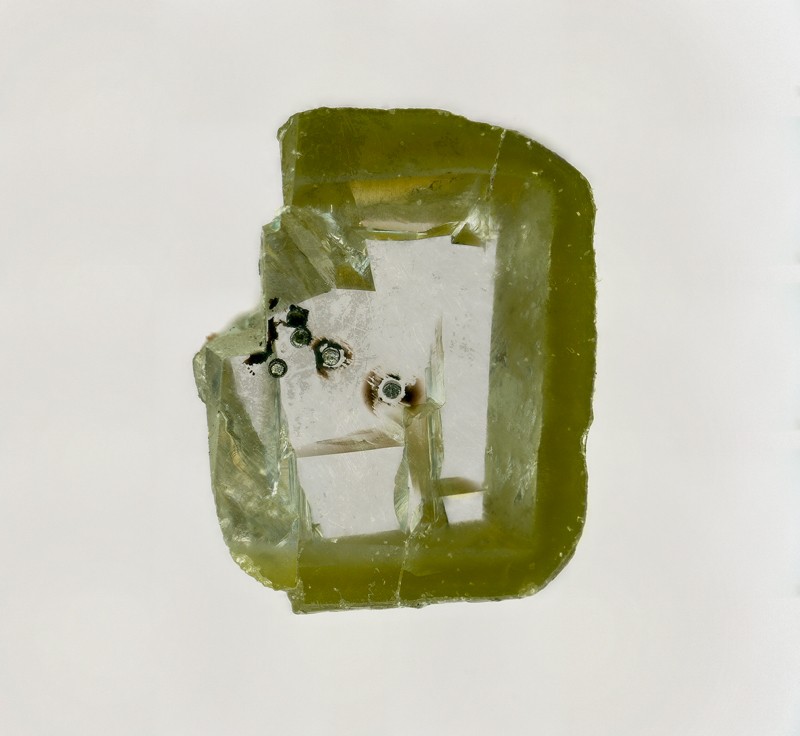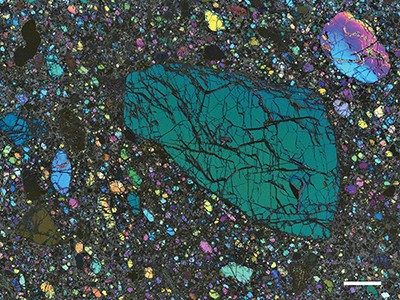Small black specks in a diamond from an African mine have turned out to be a vital ingredient of the deep Earth, identified in nature for the first time after decades of searching.
It is a rare glimpse of a mineral that normally cannot exist on Earth’s surface but plays a major part in heat flow deep inside the planet, says Oliver Tschauner, a geochemist at the University of Nevada, Las Vegas. He led the team that reported the discovery on 11 November in Science1.
Tschauner named the mineral davemaoite after Ho-kwang ‘Dave’ Mao, a scientist who made many pioneering discoveries in high-pressure geochemistry and geophysics. Davemaoite is mostly calcium silicate (CaSiO3), but it can scavenge radioactive isotopes of uranium, thorium and potassium. These isotopes generate a lot of heat in the lower portion of Earth’s mantle — the layer that lies between the planet’s crust and core. That makes davemaoite an important player in managing how heat moves through the deep Earth and, in turn, how heat cycles between the mantle and crust to drive processes such as plate tectonics.
The mineral exists only at high pressures and temperatures such as those found in the lower mantle, 660–2,700 kilometres below the surface. But these particular specks were embedded inside a diamond that ferried the mineral intact from deep in the Earth. “It’s the strength of the diamond that keeps the inclusions at high pressure,” says Tschauner.
The greenish, octahedral-shaped diamond was dug up decades ago in Botswana at the Orapa mine, the world’s largest opencast diamond mine. In 1987, a mineral dealer sold the diamond to George Rossman, a mineralogist at the California Institute of Technology in Pasadena. Tschauner, Rossman and their colleagues began studying it several years ago as part of an investigation into minerals trapped in deep-Earth diamonds.
The scientists zapped the diamond with X-rays at the Advanced Photon Source in Lemont, Illinois, which revealed that the inclusions were rich in a calcium mineral. Further studies confirmed it to be calcium silicate, which can adopt different crystalline forms depending on the temperature and pressure at which it was created. The version in the diamond has a perovskite crystal structure that only forms at the temperatures and pressures found between 660 and 900 kilometres deep, says Tschauner. Scientists had made high-pressure calcium silicate perovskite in the laboratory2, and theorized that it should exist in the lower mantle, but had never conclusively seen it in geological samples before.
In 2018, another research team reported finding calcium silicate perovskite in a deep-Earth diamond from South Africa3. But those scientists did not claim an official discovery of a new mineral. Tschauner’s team did — so Tschauner called Mao and asked if he could name the mineral after him. “Of course I gladly agreed,” says Mao, who is director of the Center for High Pressure Science and Technology Advanced Research in Shanghai, China.
The International Mineralogical Association approved davemaoite’s name last year. It is the second high-pressure mineral named after Mao; in 2018, researchers from China reported finding a different one, which they named maohokite, in rocks from an impact crater.
Davemaoite is one of three main minerals in Earth’s lower mantle, Tschauner says, making up around 5–7% of the material there. But it is the only one of the three that hosts uranium and thorium. The mineral’s crystalline structure allows its calcium to be easily swapped for these elements, which produce heat through radioactive decay.
Other diamonds out there might contain traces of davemaoite. The one found at Orapa is rich in potassium — so one way to find more davemaoite might be to look for deep diamonds in potassium-rich areas, says Yingwei Fei, a geochemist at the Carnegie Institution for Science in Washington DC.
“I will definitely look for it,” says Tschauner.
Article From & Read More ( Diamond delivers long-sought mineral from the deep Earth - Nature.com )https://ift.tt/3C7rwlm
Science


No comments:
Post a Comment